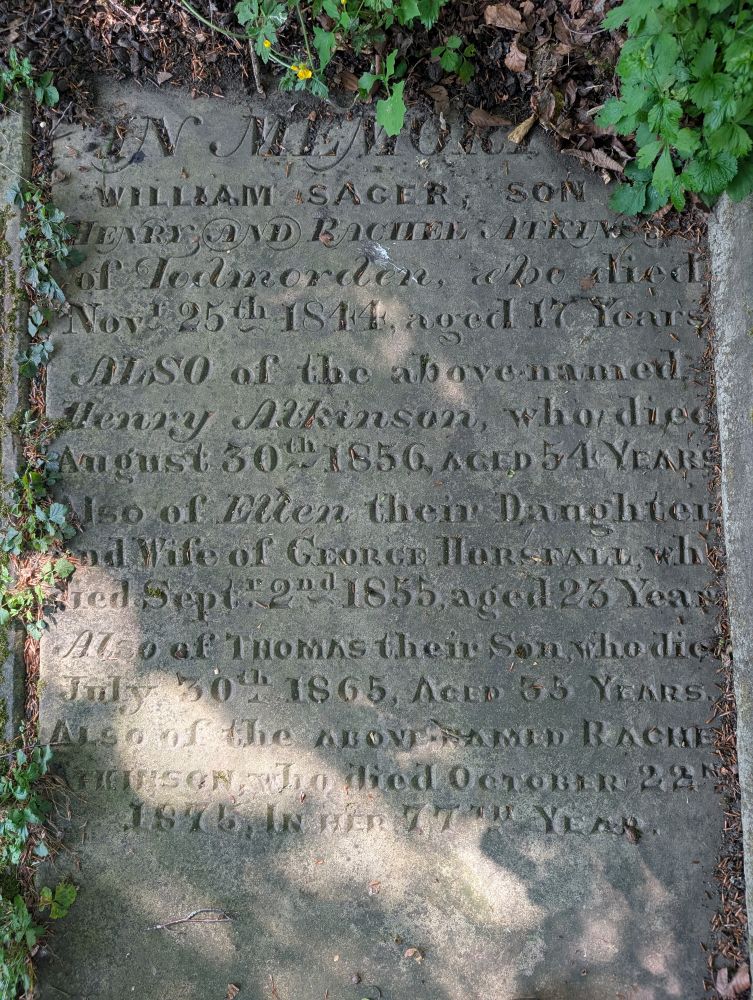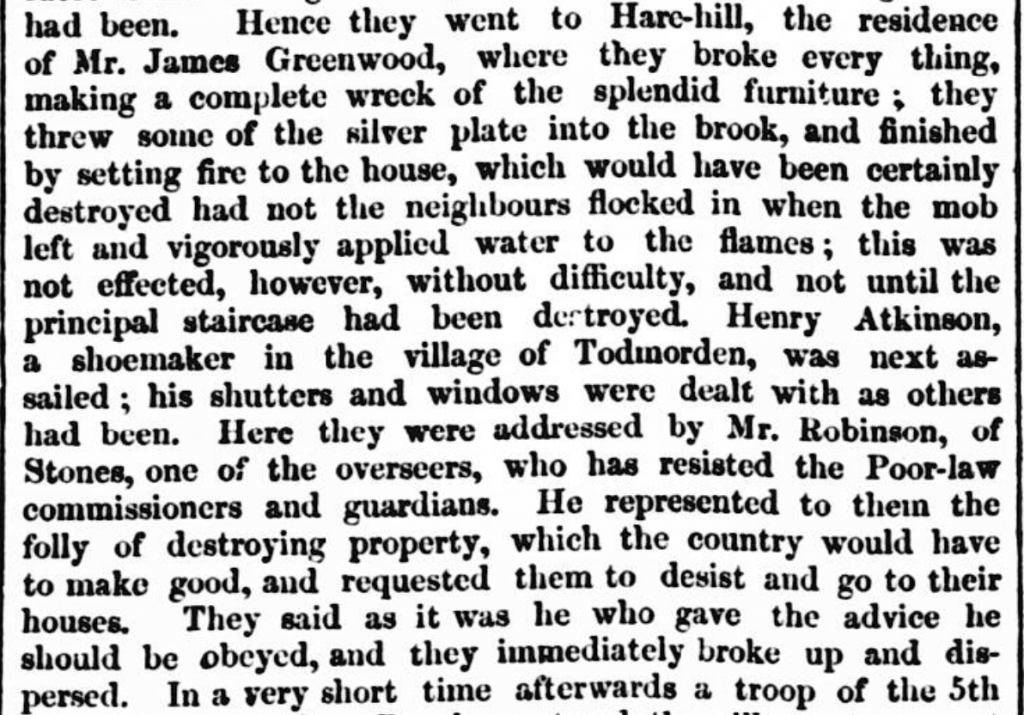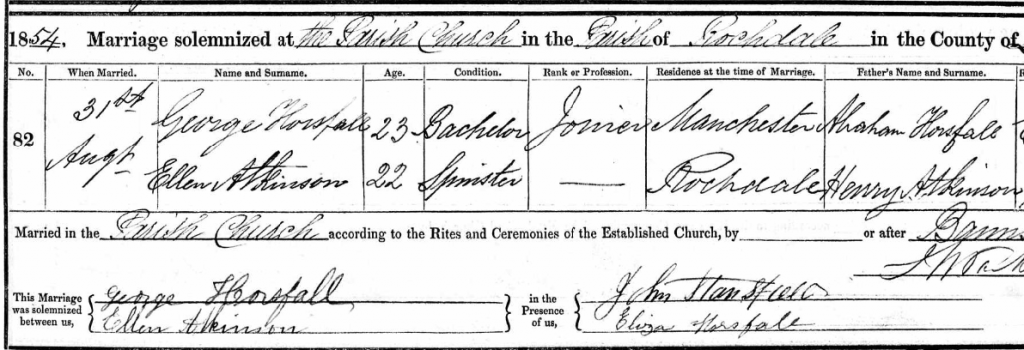A family who were swept up in the Poor Law Riots, and an emigration that ended in tragedy.

Henry Atkinson – the man of the house here – was born in Bowling, Bradford, in 1802. His father was a farmer but Henry was good with his hands and found himself apprenticing to a shoemaker, whose trade he learned and then took with him all the way down to Todmorden. He was a Church of England chap but found himself drawn to a young woman from a very different background – Rachel Sager, the daughter of local Quakers William and Sarah.

Rachel was four years Henry’s senior and from a family which was hardworking and very well-respected locally; her father William was a cordwainer, explaining how she and Henry met, her brother William would run a successful grocery and spirits business and settle at Holly House above Stansfield Hall, and his son would become one of Todmorden’s leading solicitors…but that’s a story for when we get to the private grounds, as he and his wives and some children are buried at E4.3 and 4.4.

Henry and Rachel here married at St. Chad’s in 1819. Yes, that does make Henry 17 years old, but let’s not get into that. They were definitely keen to build a small empire of Atkinsons since between 1819 and 1841 they had eight children together. Henry was also building his shoemaking empire, although that’s probably a massive overstatement – he was busy establishing himself, let’s put it that way eh? His shop on York Street did well and his eldest son John began to work alongside him and the many others he employed. He also had some political savvy and aligned himself with the Anti-Corn Law League which found itself opposed to the more radical Fieldens, and whose members were known to get into boisterous arguments with local Chartists. Henry’s power moves culminated in him agreeing to be one of the new Poor Law Guardians. Yes, that popular Poor Law of 1834, which led to zero local opposition…

Poor Henry and particularly poor Rachel and any children still at home – they must have wished that Mr. Robinson had told the crowd to calm down before it trashed their house! But that’s the price of going along with an unpopular law in your home town. In the end it didn’t hurt his business any, and post-riots things more or less settled down. What would the Sagers have made of this? Would their sympathies have lain with fellow Quakers (or Quaker-origin) the Fieldens, or would they have understood?
Things were not settled for long in the Atkinson family, though, because in 1844 their second oldest son William Sager Atkinson died at the age of 17. This will have been a great blow to his parents and they’ll have been counting themselves lucky as the years passed and their other children continued to thrive. John went to live on Union Street with his new wife and three other shoemakers, Thomas went off to Halifax to work as an iron turner, and Ellen worked alongside Henry as a shoe binder while the younger children continued to go to school. In 1854 or maybe earlier, though, Ellen met a man – George Horsfall.

George was a joiner who also lived on York Street with his parents Abraham and Lydia. Abraham was an engineer but his sons Greenwood and George both preferred woodwork. George also, it seemed, preferred adventure. He and Ellen married in August 1854 and by December they had disembarked from the ship Sultana at the docks of Melbourne, Australia. Why? The 1850s were a busy decade for immigration due to the discovery of gold and even if he didn’t have gold on his mind, George might have accurately predicted the need for someone to build houses for the people searching for gold. Having said that, his occupation on the passenger manifest is “farmer”, so maybe he and Ellen were trying something new. These crossings were notoriously rough and even though both survived, Ellen was likely weakened from the experience. She died there on September 2nd or 3rd 1855. Her grave here says the 2nd, but the grave’s entry says the 3rd. No stone exists for her but her resting place at Melbourne General Cemetery is known and marked with iron railings. George would remarry in a few years time and died in Australia in 1879, having never returned.
The following year Henry died and was buried here, and when you look at the order of deaths on this stone you’ll notice his name and details come before Ellen’s. We do wonder if the Atkinsons didn’t find out about Ellen’s death until after Henry’s and had to be added on later. So, September 2nd or 3rd? Who knows which one is correct. We can’t take this information as given if it arrived over a year after the fact!
Rachel was now a wealthy widow and seems to have spent a great deal of her time as a widow going about and visiting others. In 1861 she could be found on the census visiting North View next door, and specifically young Joseph Firth, who her daughter Mary had looked after when she was younger as a servant to artist and schoolteacher William and Sarah Dewhirst (whose father was business partners with Rachel’s cousin). Meanwhile son Thomas had gone from Halifax to Bolton where he met and married Martha Daniels, a servant, who he brought back to Todmorden within a few years after a brief detour to Saddleworth. The couple had three children before Thomas died in 1865, and Martha made the curious decision to stay in Todmorden despite apparently having little to no support from the Atkinsons. Perhaps the fact that she had two illegitimate children in 1870 and 1877 by the same man, John Stansfield, had something to do with it. Was he the same John Stansfield as witnessed George Horsfall and Ellen Atkinson’s wedding? Maybe. It might explain Martha being on the outs with her in-laws and spending the rest of her days working as a laundress and charwoman.

Rachel had now lost three children, and buried two, here with her husband; but she continued on with her widow’s annuity. It may have been starting to run out, though, because by 1871 she was living at Holly House with her nephew William. This came to an end eventually and when Rachel died in 1875 at the age of 77 she was living at Albion House next to North View; Joseph Firth may have remembered her fondly and sorted out a place for her to spend her final days. Her residence in the papers however is Rodwell End…who knows what was going on. Perhaps she was perpetually visiting family members for her last twenty years?